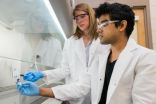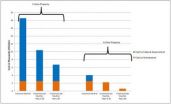(Press-News.org) JUPITER, FL, July 17, 2014 – It is something of an eternal question: Can we slow or even reverse the aging process? Even though genetic manipulations can, in fact, alter some cellular dynamics, little is known about the mechanisms of the aging process in living organisms.
Now scientists from the Florida campus of The Scripps Research Institute (TSRI) have found in animal models that a single gene plays a surprising role in aging that can be detected early on in development, a discovery that could point toward the possibility of one day using therapeutics, even some commonly used ones, to manipulate the aging process itself.
"We believe that a previously uncharacterized developmental gene known as Spns1 may mediate the aging process," said Shuji Kishi, a TSRI assistant professor who led the study, published recently by the journal PLOS Genetics. "Even a partial loss of Spns1 function can speed aging.
Using various genetic approaches to disturb Spns1 during the embryonic and/or larval stages of zebrafish—which have emerged as a powerful system to study diseases associated with development and aging—the scientists were able to produce some models with a shortened life span, others that lived long lives.
While most studies of "senescence"—declines in a cell's power of division and growth—have focused on later stages of life, the study is intriguing in exploring this phenomenon in early stages. "Mutations to Spns1 both disturbs developmental senescence and badly affects the long-term bio-chronological aging process," Kishi said.
The new study shows that Spns1, in conjunction with another pair of tumor suppressor genes, beclin 1 and p53 can, influences developmental senescence through two differential mechanisms: the Spns1 defect was enhanced by Beclin 1 but suppressed by 'basal p53.' In addition to affecting senescence, Spns1 impedes autophagy, the process whereby cells remove unwanted or destructive proteins and balance energy needs during various life stages.
Building on their insights from the study, Kishi and his colleagues noted in the future therapeutics might be able to influence aging through Spns1. He noted one commonly used antacid, Prilosec, has been shown to temporarily suppress autophagic abnormality and senescence observed in the Spns1 deficiency.
INFORMATION:
The first author of the study, "Aberrant Autolysosomal Regulation Is Linked to The Induction of Embryonic Senescence: Differential Roles of Beclin 1 and p53 in Vertebrate Spns1 Deficiency," is Tomoyuki Sasaki of TSRI. Other authors include Shanshan Lian, Jie Qi, Sujay Guha, Jennifer L. Johnson, Sergio D. Catz and Matthew Gill of TSRI; Peter E. Bayliss of the University Health Network, Toronto, Canada; Christopher E. Carr of the Massachusetts Institute of Technology; Patrick Kobler and Kailiang Jia of Florida Atlantic University; and Daniel J. Klionsky of the University of Michigan. The paper can be accessed at http://www.plosgenetics.org/article/info%3Adoi%2F10.1371%2Fjournal.pgen.1004409
The work was supported by The Ellison Medical Foundation, Glenn Foundation for Medical Research, the A-T Children's Project, the National Institutes of Health (NIH) National Institute of Aging (AG022641) and the National Institute of General Medical Sciences (GM053396, GM101508).
Scripps Florida scientists identify gene that plays a surprising role in combating aging
2014-07-17
ELSE PRESS RELEASES FROM THIS DATE:
Crohn's disease research
2014-07-17
University of Delaware researchers have identified a protein, hiding in plain sight, that acts like a bodyguard to help protect and stabilize another key protein, that when unstable, is involved in Crohn's disease. The fundamental research points to a possible pathway for developing an effective therapy for the inflammatory bowel disease.
The research, by Catherine Leimkuhler Grimes, assistant professor of chemistry and biochemistry at UD, and Vishnu Mohanan, doctoral student in biological sciences, is published in the July 4 issue of the Journal of Biological Chemistry. ...
Carnegie Mellon combines hundreds of videos to reconstruct 3D motion without markers
2014-07-17
PITTSBURGH—Carnegie Mellon University researchers have developed techniques for combining the views of 480 video cameras mounted in a two-story geodesic dome to perform large-scale 3D motion reconstruction, including volleyball games, the swirl of air currents and even a cascade of confetti.
Though the research was performed in a specialized, heavily instrumented video laboratory, Yaser Sheikh, an assistant research professor of robotics who led the research team, said the techniques might eventually be applied to large-scale reconstructions of sporting events or performances ...
Incidence of stroke in the elderly has dropped by 40 percent over the last 20 years
2014-07-17
Philadelphia, PA, July 17, 2014 – A new analysis of data from 1988-2008 has revealed a 40% decrease in the incidence of stroke in Medicare patients 65 years of age and older. This decline is greater than anticipated considering this population's risk factors for stroke, and applies to both ischemic and hemorrhagic strokes. Investigators also found death resulting from stroke declined during the same period. Their findings are published in the July issue of The American Journal of Medicine.
Preventable but deadly, stroke is the fourth leading cause of mortality in the ...
NYU Langone investigators to present new research at 2014 Alzheimer's Association International Conference
2014-07-17
(New York, NY, July 12, 2014) - Researchers from the Center for Cognitive Neurology (CCN) at NYU Langone Medical Center, NYU School of Medicine, and the Nathan S. Kline Research Institute will present new findings at the 2014 Alzheimer's Association International Conference in Copenhagen, Denmark, July 12 – 17, 2014.
The Center for Cognitive Neurology is a multidisciplinary, integrated center devoted to research, clinical care and clinical advances toward the treatment and cure of neurological diseases affecting cognition -- focused on memory, language, attention, auditory, ...
The rate at which groundwater reservoirs are being depleted is increasing
2014-07-17
FRANKFURT.In what parts of the world and to what degree have groundwater reservoirs been depleted over the past 50 years? The Frankfurt hydrologist Prof. Petra Döll has been researching this using the global water model WaterGAP. She has arrived at the most reliable estimate to date by taking into consideration processes which are important in dry regions of the world. The values calculated were compared with monitoring data from many different wells and data from the GRACE satellites. These satellites measure changes in the Earth's gravity field. Döll has come to the conclusion ...
What are the risks of post-traumatic stress disorder after an accident?
2014-07-17
This news release is available in French. Many patients continue to suffer from symptoms (headaches, pain) several months after an accident, which can pose a real handicap to their lives. The team of Emmanuel Lagarde, research director at Inserm's Research Centre for Epidemiology and Biostatistics (Inserm/University of Bordeaux) has studied the subsequent development of 1,300 people who were admitted to A&R between 2007 and 2009 for trauma. The researchers demonstrate that it is possible to identify people who will develop post-traumatic stress disorder, which generally ...
Danish DNA could be key to happiness
2014-07-17
Genetics could be the key to explaining nation's levels of happiness, according to research from the University of Warwick.
Economists at the University's Centre for Competitive Advantage in the Global Economy (CAGE) have looked at why certain countries top the world happiness rankings. In particular they have found the closer a nation is to the genetic makeup of Denmark, the happier that country is. The research could help to solve the puzzle of why a country like Denmark so regularly tops the world happiness rankings.
Dr Eugenio Proto and Professor Andrew Oswald ...
Potential new therapy with brain-on-a-chip axonal strain injury model
2014-07-17
University of Houston researchers have devised a new method for extracting molecules from live cells without disrupting cell development, work that could provide new avenues for the diagnosis of cancer and other diseases.
The researchers used magnetized carbon nanotubes to extract biomolecules from live cells, allowing them to retrieve molecular information without killing the individual cells. A description of the work appears this week in the Proceedings of the National Academy of Sciences.
Most current methods of identifying intracellular information result ...
Is the US National Flood Insurance Program affordable?
2014-07-17
There is often tension between setting insurance premiums that reflect risk and dealing with equity/affordability issues. The National Flood Insurance Program (NFIP) in the United States recently moved toward elimination of certain premium discounts, but this raised issues with respect to the affordability of coverage for homeowners in flood-prone areas. Ultimately, Congress reversed course and reinstated discounted rates for certain classes of policyholders.
Carolyn Kousky (Resources for the Future, USA) and Howard Kunreuther's (The Wharton School, University of Pennsylvania, ...
Plasmon-enhanced Polarization-selective filter
2014-07-17
As we all know, some optical devices can only work with a certain incident polarization direction. In this case, a polarizer is necessary to shift the polarization direction of linearly polarized light. A common polarizer is also called half-wave plate, which constructed out of a birefringent material (such as quartz or mica). The behaviour of a half-wave plate depends on the thickness of the crystal, the wavelength of light. Considering the fabrication of crystal, a half-wave plate is difficulty to integrate on circuits. Then what kind of polarizer can be integrated on ...




